As outdoor WiFi cameras become more interconnected, cybersecurity becomes a critical consideration. In this technically-oriented blog post, we delve into the significance of robust cybersecurity measures in outdoor WiFi cameras.
Cybersecurity vulnerabilities can expose outdoor WiFi cameras to hacking and unauthorized access. Reputable manufacturers implement strong encryption protocols to protect data transmission and storage, ensuring that only authorized users can access camera feeds.
Firmware updates are essential for addressing security vulnerabilities and maintaining camera performance. Regularly updating camera firmware ensures that the latest security patches are applied.
Secure authentication methods, such as multi-factor authentication (MFA), add an extra layer of protection. MFA requires users to provide two or more forms of verification before accessing camera feeds or settings.
Some outdoor WiFi cameras include intrusion detection systems that can identify and notify users of any unusual activity or unauthorized access attempts.
Furthermore, the separation of camera networks from other IoT devices and main networks helps prevent potential breaches from spreading to other devices.
In conclusion, robust cybersecurity measures are imperative for protecting outdoor WiFi cameras from hacking and unauthorized access. By implementing encryption, regular updates, strong authentication, and network segmentation, manufacturers and users can ensure the security of these devices.







